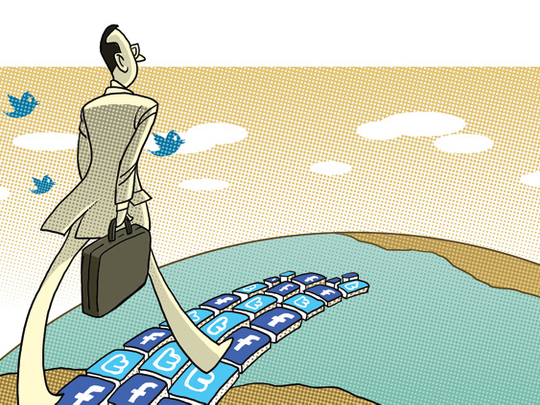
Twentieth-century American statecraft produced Dean Acheson, Henry Kissinger, Richard Holbrooke and many others who balanced the power of the US with its responsibilities to develop key relationships, solve problems and build international structures. “21st Century statecraft,” we have been told repeatedly, promises to go further and deliver more, for now US diplomats — and those of other countries — can use Twitter, Facebook and other social media.
With so many international problems today, diplomacy does need to combine the old-fashioned statecraft of the 20th Century with the new tools that budding technologies have provided. But tools alone cannot solve or build anything.
And yet the new tools are everywhere. It is hard to find a US ambassador in any part of the world who has not embraced the challenge of mastering these communication technologies. Most have a Twitter or Facebook account or post frequently on YouTube, in order to keep the public in the countries where they serve (and at home) informed of their daily activities or occasionally their thinking about an issue or even their mood. The State Department estimates that its employees are in direct communication with more than 15 million people worldwide. Incredibly enough, more than 330,000 people “like” the personality-challenged department’s Facebook page.
This generation of American diplomats is fast overcoming a reputation for being remote, emotionally distant figures. To be fair, in the past, an ambassador had few opportunities to connect with the host country’s population, apart from the occasional newspaper or television interview or a photo of a meeting with a host country official or waiting on an airport’s tarmac for a visitor from Washington, DC. Now, as America’s tweeting diplomats have shown, there is no shortage of such opportunities.
Time constraints are not an issue. Most US embassies ensure a constant stream of tweets by relying on public-diplomacy officers to get the word out about what the ambassador is doing day by day, even hour by hour. Many ambassadors have built mass followings in electronic terms and generate numerous “likes” as they go about their daily routines of meetings and ribbon-cuttings. All fun stuff.
But have social media really made for better diplomats or helped solve difficult problems? If so, why are there so many unmitigated and unmediated crises around the world — Syria’s civil war, the carnage in Egypt and deteriorating US-Russia relations, to name just a few. The much-ballyhooed 21st-Century statecraft, it seems, is really not up to the job.
Advocates accurately point out that social media are a tool that is ignored at one’s peril. But what is urgently needed today is an understanding that diplomacy is not only about shouting from the rooftops and communicating with the general public. It is about working on relationships one at a time. Above all, it is about keeping the door open to deal with unsavoury governments.
Governments, even terrible ones, comprise the people who lead a country. Maybe they should not be in power; maybe the people demonstrating in the streets should be. But, in the here and now, these relationships need to be maintained in order to help polarised societies make progress towards overcoming their divisions.
The US Ambassador to Egypt, Anne W. Patterson, was excoriated in the media — especially in social media, which have no international boundaries (and often no manners) — for her courageous efforts to keep the door open for dialogue with the Muslim Brotherhood government. She did what any good — and, in her case, superb — diplomat should do: Maintain relations with both sides and try to find a way forward. Indeed, the Muslim Brotherhood government and the secular opposition both complained about America’s relationship with the other.
That is the hot seat where American diplomacy belongs. With all due respect to “eDiplomacy,” this type of private, traditional communication remains the heart and soul of the business.
Similarly, Secretary of State John Kerry has launched a courageous effort to revive the Israel-Palestine peace process. Given the dearth of public information about his strategy, it is clear that he is not an avid practitioner of 21st Century statecraft — that is, he does not think out loud. And yet he got the parties together by developing trust, which is the coin of the realm for an effective diplomat.
It is perhaps a little unfair to contrast these efforts to what the US did in Syria. In an effort to stay ahead of intense media expectations (and reflecting a misunderstanding according to which Syria would be just another Tunisia), President Barack Obama’s administration essentially severed America’s relationship with Bashar Al Assad’s regime by publicly embracing the disparate opposition and calling for Al Assad’s immediate removal.
The US did not offer any clear indication of what it thought should follow such an outcome, apart from some kind of election process, which in a largely sectarian conflict like Syria’s would amount to nothing more than an elaborate census. Lo and behold, political leaders, especially tough and terrible ones like Al Assad, tend not to embrace a process whose stated purpose is to eliminate them.
US diplomats — indeed, all countries’ diplomats — might want to consider that, rather than chasing record numbers of social media “followers,” they should be building trust on all sides in conflict-prone societies and looking for more leaders willing to take chances for peace. When the shooting has stopped and the sides are talking, diplomats can tweet to their hearts’ content.
— Project Syndicate, 2013
Christopher R. Hill, former US assistant secretary of state for East Asia, is Dean of the Korbel School of International Studies, University of Denver.









